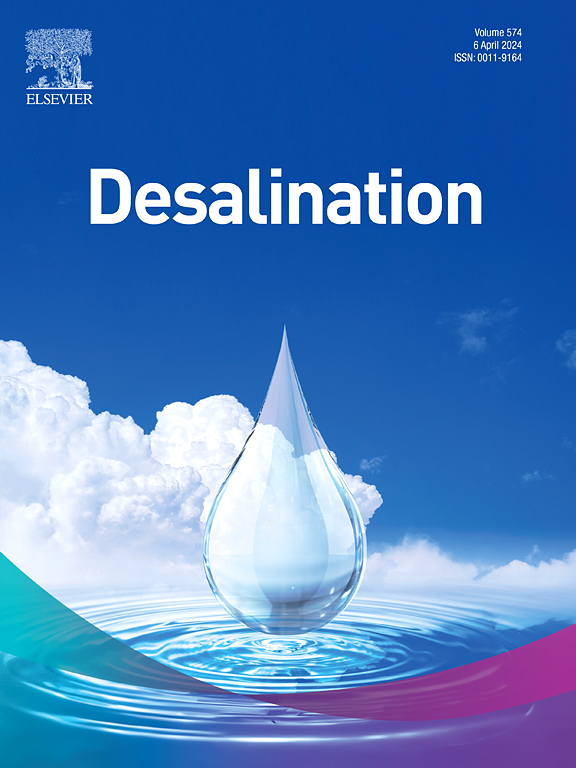High recovery design of reverse osmosis process with high permeate water quality and low wastewater discharge for ultra-pure water production
IF 8.3
1区 工程技术
Q1 ENGINEERING, CHEMICAL
引用次数: 0
Abstract
Ultra-pure water (UPW) for electronic industry is produced via many unit processes including reverse osmosis (RO), pretreatments, membrane degasifier, and ion exchange processes. Generally, 2-pass RO system is adopted in UPW production process to remove ionic and organic matters to meet water quality requirements of post-treatments. Since RO concentrate occupies most of wastewater discharged from UPW production process, high recovery design is beneficial to reduce wastewater discharge. According to the solution-diffusion model, permeate concentrations increase at higher feed concentrations, which may limit to increase RO recovery. Interestingly, the bench-scale 2-pass RO test using five commercial membrane modules revealed permeate concentrations were not affected by feed concentrations below a critical value (35 mg/L as NaCl in this work). This means the first-pass RO recovery can be increased without decreasing permeate water quality as far as second-pass RO feed concentrations are below the critical values. Various 2-pass UPW-RO system designs (250 mg/L as NaCl of feed concentration) were analyzed using an industrial RO system simulator to investigate the effect of the first- and second-pass recovery. The simulation works found that increasing the first- and second-pass recovery decreased wastewater discharge, energy consumption, and the number of membrane modules without degrading permeate water quality.
为超纯水生产设计高渗透水质和低废水排放的高回收率反渗透工艺
电子工业用超纯水(UPW)是通过许多单元工艺生产出来的,包括反渗透(RO)、预处理、膜脱气器和离子交换工艺。一般来说,超纯水生产过程中采用 2 级反渗透系统来去除离子和有机物,以满足后处理的水质要求。由于反渗透浓缩物占 UPW 生产工艺排放废水的大部分,因此高回收率设计有利于减少废水排放。根据溶液扩散模型,进水浓度越高,渗透液浓度越高,这可能会限制反渗透回收率的提高。有趣的是,使用五种商用膜组件进行的台式 2 级反渗透测试表明,渗透液浓度在临界值(本工作中为 35 毫克/升 NaCl)以下不受进料浓度的影响。这意味着,只要第二道反渗透进水浓度低于临界值,就可以提高第一道反渗透回收率而不降低渗透水的水质。我们使用工业反渗透系统模拟器分析了各种 2 流程 UPW-RO 系统设计(进水浓度为 NaCl 250 毫克/升),以研究第一和第二流程回收率的影响。模拟工作发现,提高第一和第二道回收率可减少废水排放量、能耗和膜组件数量,同时不会降低渗透水质。
本文章由计算机程序翻译,如有差异,请以英文原文为准。
求助全文
约1分钟内获得全文
求助全文
来源期刊

Desalination
工程技术-工程:化工
CiteScore
14.60
自引率
20.20%
发文量
619
审稿时长
41 days
期刊介绍:
Desalination is a scholarly journal that focuses on the field of desalination materials, processes, and associated technologies. It encompasses a wide range of disciplines and aims to publish exceptional papers in this area.
The journal invites submissions that explicitly revolve around water desalting and its applications to various sources such as seawater, groundwater, and wastewater. It particularly encourages research on diverse desalination methods including thermal, membrane, sorption, and hybrid processes.
By providing a platform for innovative studies, Desalination aims to advance the understanding and development of desalination technologies, promoting sustainable solutions for water scarcity challenges.
 求助内容:
求助内容: 应助结果提醒方式:
应助结果提醒方式:


